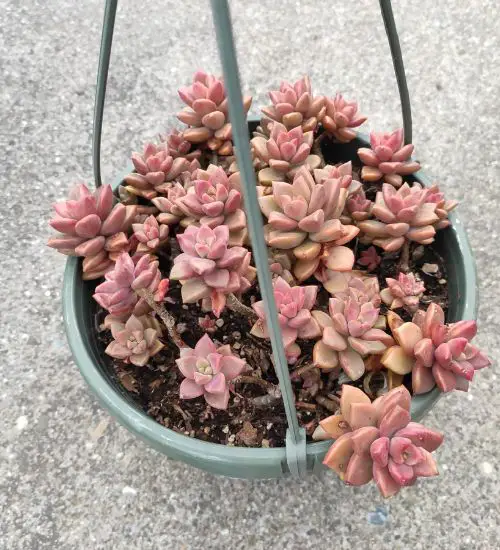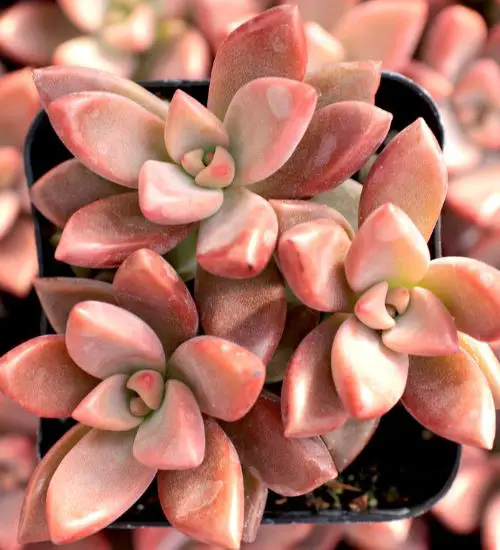Sun: full sun to partial shade
Water: Typical water needs for a succulent
Temperature: Zone 10a from 30° F to 35° F (-1.1 ° C to 1.7° C)
Winter Survival: Not cold hardy
Propagation: leaves, offsets, stem cuttings, seeds
Flower: In the Spring
Flower Type:
Toxic: Generally non-toxic to humans and animals
Dormant: summer
Space Requirement: Indoors & Outdoors
Common Problems: Plants may rot if overwatered, pests
Where to buy Graptosedum ‘Alpenglow’?
Basc Care for Graptosedum ‘Alpenglow’
Watering
Regular watering period should be every 2 weeks
One simple tip for you is that you can use some online apps to check the soil status before you go water your succulents. I would recommend the ThePlantsCheck app, it has some nice features there.
Fertilizing
Only feed this succulent during its active growing seasons which means spring and fall. Use the right fertilizer applied in the right amounts. Applying half-strength balanced fertilizer every month or so is recommended for optimal results.
Do not fertilize during summer as the plant is dormant.
Sun & Location Requirements for "Graptosedum ‘Alpenglow’"
Graptosedum ‘Alpenglow’ requires full sun to partial shade in order to stay healthy and vibrant. Always keep an eye on the temperatures and light levels as too much direct sunlight can be damaging to this type of succulent. If you notice any signs of distress, try moving it to a shadier spot within your garden or home.
Graptosedum ‘Alpenglow’ is not cold hardy and does not survive in freezing conditions. However, there are certain strategies that can be used to help the plant thrive despite the chill of winter. Proper drainage and insulation are essential for succulent X during periods of extreme cold. Placing a layer of mulch or gravel on the soil around the plant can also help keep it warm.
Graptosedum ‘Alpenglow’ also benefits from some indirect light throughout the day as well, so make sure you give it enough space to soak up light without becoming too exposed to heat.
Propagation
Propagating succulents from leaves is an easy and cost-effective way to grow new plants. All you need are a few healthy leaves from the mother plant, some potting mix, and regular watering. After a few weeks you'll have brand new succulents that you can watch grow!
Offsets are an easy and reliable way to propagate succulents, like Graptosedum ‘Alpenglow’. With just a few simple steps, you can get a brand-new plant from an existing one.
Propagating Graptosedum ‘Alpenglow’ by stem cuttings is an easy and fun way to increase your collection of these unique houseplants. When propagating, it’s important to choose healthy stems from existing plants that are at least two inches long and have several leaves attached.
Propagating Graptosedum ‘Alpenglow’ from seeds is a great way to produce new plants without relying on cuttings or divisions. It's important to look for healthy, dark and plump seeds that are slightly sticky when touched. The soil should be pre-mixed with well-draining potting mix, before evenly sowing the seeds and pressing them into the surface. To ensure successful germination, gentle misting of the soil should be done and placed in indirect light.
Toxicity

Graptosedum ‘Alpenglow’ is not known to pose any significant health risks, as it is not considered to be toxic. However, it is best to keep the plant away from young children and pets, as they may ingest some of the parts of this plant that could contain toxins which can cause mild skin irritation.
Pests and Diseases
Graptosedum ‘Alpenglow’ can be affected common pests and diseases like most of the other succulents such as aphids and mealybugs.
If you do spot any of pest signs, you can treat your succulent using below methods.
- Aphids: quarantine, clean infected plants, soapy water.
- Mealybugs: quarantine, clean infected plants, soapy water.
Besides that, to prevent serious health issues from happening, keep your succulent in a well-ventilated area and check it regularly for any signs of pests or health problems.


